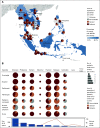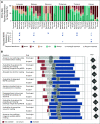Pediatric Solid Tumor Care and Multidisciplinary Tumor Boards in Low- and Middle-Income Countries in Southeast Asia
- PMID: 32886560
- PMCID: PMC7529532
- DOI: 10.1200/GO.20.00284
Pediatric Solid Tumor Care and Multidisciplinary Tumor Boards in Low- and Middle-Income Countries in Southeast Asia
Abstract
Purpose: Pediatric solid tumors require coordinated multidisciplinary specialist care. However, expertise and resources to conduct multidisciplinary tumor boards (MDTBs) are lacking in low- and middle-income countries (LMICs). We aimed to profile the landscape of pediatric solid tumor care and practices and perceptions on MDTBs among pediatric solid tumor units (PSTUs) in Southeast Asian LMICs.
Methods: Using online surveys, availability of specialty manpower and MDTBs among PSTUs was first determined. From the subset of PSTUs with MDTBs, one pediatric surgeon and one pediatric oncologist from each center were queried using 5-point Likert scale questions adapted from published questionnaires.
Results: In 37 (80.4%) of 46 identified PSTUs, availability of pediatric-trained specialists was as follows: oncologists, 94.6%; surgeons, 91.9%; radiologists, 54.1%; pathologists, 40.5%; radiation oncologists, 29.7%; nuclear medicine physicians, 13.5%; and nurses, 81.1%. Availability of pediatric-trained surgeons, radiologists, and pathologists was significantly associated with the existence of MDTBs (P = .037, .005, and .022, respectively). Among 43 (89.6%) of 48 respondents from 24 PSTUs with MDTBs, 90.5% of oncologists reported > 50% oncology-dedicated workload versus 22.7% of surgeons. Views on benefits and barriers did not significantly differ between oncologists and surgeons. The majority agreed that MDTBs helped to improve accuracy of treatment recommendations and team competence. Complex cases, insufficient radiology and pathology preparation, and need for supplementary investigations were the top barriers.
Conclusion: This first known profile of pediatric solid tumor care in Southeast Asia found that availability of pediatric-trained subspecialists was a significant prerequisite for pediatric MDTBs in this region. Most PSTUs lacked pediatric-trained pathologists and radiologists. Correspondingly, gaps in radiographic and pathologic diagnoses were the most common limitations for MDTBs. Greater emphasis on holistic multidisciplinary subspecialty development is needed to advance pediatric solid tumor care in Southeast Asia.
Conflict of interest statement
Chatchawin Assanasen
Catherine Lam
No other potential conflicts of interest were reported.
Figures




References
-
- Tan AM, Ha C, Li CF, et al. VIVA-Asia Blood and Marrow Transplantation Groups – A survey of consortium activity over a 12-year period (2000 to 2011) Ann Acad Med Singapore. 2016;45:106–109. - PubMed
-
- Ali K, Sutaryo S, Purwanto I, et al. Yogyakarta Pediatric Cancer Registry: An international collaborative project of University Gadjah Mada, University of Saskatchewan, and the Saskatchewan Cancer Agency. Asian Pac J Cancer Prev. 2010;11:131–136. - PubMed
-
- Park KD, Hong CR, Choi JY, et al. Foundation of pediatric cancer treatment in Lao People’s Democratic Republic at the Lao-Korea National Children’s Hospital. Pediatr Hematol Oncol. 2018;35:268–275. - PubMed
Publication types
MeSH terms
LinkOut - more resources
Full Text Sources
Medical

